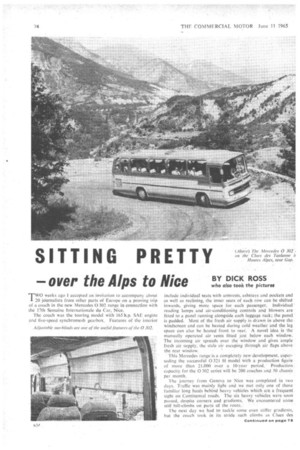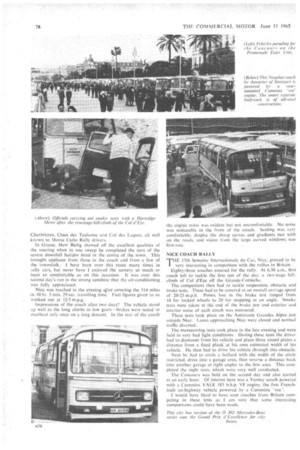SITTING PRETTY
Page 76

Page 78

If you've noticed an error in this article please click here to report it so we can fix it.
over the Alps to Nice
BY DICK ROSS
who also took the pictures 'TWO weeks ago 1 accepted an invitation to accompany about 1.20 journalists from other parts of Europe on a proving trip of a coach in the new Mercedes 0 302 range in connection with the 17th Semaine Internationale du Car, Nice.
The coach was the touring. model with 165 h.p. SAE engine and five-speed synchromesh gearbox. Features of the interior
include individual seats with armrests, ashtrays and pockets and as well as reclining, the inner seats of each row can be shifted inwards, giving more space for each passenger. Individual reading lamps and air-conditioning controls and blowers are fitted to a panel running alongside each luggage rack; the panel is padded. Most of the fresh air supply is, drawn in above the windscreen and can be heated during Cold weather and the leg space can also be heated front to rear. A novel idea is 1.11 manually operated air 'vents fitted just below each window. The incoming air spreads over the window and gives ample fresh air supply; the stale air escaping through air flaps above the rear window.
This Mercedes range is a completely new development, superseding the successful 0 321 1-1 model With a production figure of more than 21,000 over a 10-year period. Production : capacity for the 0 302 series will be 200 coaches and 50 chassis per month.
The journey from Geneva to Nice was completed in two days. Traffic was Mainly light and we met only one of those familiar !Ong hauls behind heavy vehicles which are a frequent sight on Continental roads. The six heavy vehicles were soon passed, despite corners and gradients. We encountered some stiff hill-climbs on parts of the route., —
The next day we had to tackle some even stiffer gradients, but the coach took in its stride such climbs as Clues des Charbrieres, Clues des Taulanne and Col des Leque,s, all well known to Monte Carlo Rally drivers.
In Grasse, Herr Bielig showed off the excellent qualities of the steering when in one sweep he completed the turn of the severe downhill hairpin bend in the centre of the town. This brought applause from those in the coach and from a few of the townsfolk. I have been over this route many times in rally cars, but never have I enjoyed the scenery so much, or been so comfortable as on this occasion. It was over this second day's run in the strong sunshine that the air-conditioning was fully appreciated.
Nice was reached in the evening 4ter covering the 314 miles in. 1.0 hr. 3 min. 29 sec. travelling time. Fuel figures given to us worked out at 12.5 m.p.g.•
Impressions of the coach aUer two days? The vehicle stood up well to the long climbs in low gears—brakes were noted to overheat only once on a long descent. In the rear of the coach the engine noise was evident but not uncomfortable. No noise was noticeable in the front of the coach. Seating was very comfortable, despite the sharp curves and gradients met with on the roads, and vision from the large curved windows was first-rate.
NICE COACH RALLY
THE 17th Semainc Intcrnationale du Car, Nice, proved to be very interesting in comparison with the rallies in Britain. Eighty-three coachet. entered for the rally. At 0.30 a.m., first coach left to tackle the first test of the day. a two-stage hillclimb Of Col d'Eze off the Grande-Corniche.
The competitors then had to tackle suspension. obstacle and brake tests. These had to be covered at an overall average speed of 20-25 m.p.h.. Points lost in the brake test ranged from 10 for locked wheels to 20 for stopping at an angle. Smoke tests were taken at the end of the brake test and exterior and interior noise of each coach was measured.
These tests took place on the Autoroute Grandes Alpes just outside Nice. Lanes approaching Nice were closed and normal traffic diverted.
The rnanceuvring tests took place in the late evening and were held in very bad light conditions. During these tests the driver had to dismount from his vehicle and place three round plates a distance from a fixed plank at his own estimated width of his vehicle. He then had to drive his vehicle through this obstacle.
Next he had to circle a bollard with the width of the circle restricted, drive into a garage area, then reverse a distance back into another garage at right angles to the first area. This completed the night tests, which were very well conducted.
The Concours was held on the second day and also started at an early hour. Of interest here was a Verney coach powered with a Cummins VALE 185 b.h.p. V8 engine, the first Frenchbuilt on-highway vehicle powered by a Cummins vee'.
I would have liked to have seen coaches from Britain competing in these tests as I am sure that some interesting comparisons could have been made.
This city bus version of the 0 302 Mercedes-Benz series won the Grand Prix r/ Excellence )(Or city buses.




























































































































